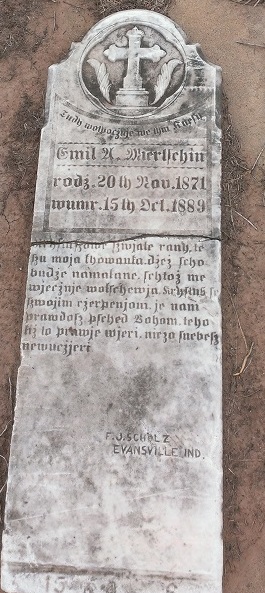First published in the Texas Wendish Heritage Society Newsletter, Vol II, No. 4 of July-September 1981.
In Texas, as had been the case in Germany previously, the Wends used German as their more official language. Therefore it is not surprising that their grave inscriptions were also in German. Until about nine months ago, I believed that there were no Wendish-language gravestones at Serbin. The only use of Wendish I had found at all was on a bilingual German and Wendish stone in the Old Warda (Old Holy Cross) cemetery,[1] which will be described below. However, last fall, while completing an article on the Wends and their gravestones, I made a last search at Serbin cemetery for any use of Wendish — and was happy to discover a beautiful Wendish inscription, apparently the only one, and previously unknown. The stone is unfortunately broken at the base and in the middle, but could probably be easily restored. This grave is not one of the oldest, but rather is from 1889 — 35 years after the arrival in Texas. It is located in the easternmost row, approximately the 19th stone from the south end. The grave is that of a not-quite-eighteen year old young man, Emil A. Miertschin, (an uncle of the present Carl Miertschin), and even today we feel the sorrow of such an untimely death. The inscription which is in beautiful Old-German letters (called “Fraktur” or “Gothic”), reads:
Tudy wotpocžuje we tym Knesu
Emil A. Měrčin[2]
rodź. 20ty Nov. 1871 (rodźeny-born)
wumr. 15ty Okt. 1889 (wumrěł-died)
Krystußowe ßwjate rany, te ßu moja khowanka,
hdžež wšo budže nawakane, štož me wjěčnje wokřewja,
Krystus z ßwojim čerpjenjom, je nam prawdoć před Bohom.
Teho kiž to prawje wěri, njeńdže z njebjeß njewučeri.

The spelling is the 19th century Lutheran Wendish standard, as was used by the Wends in Germany and Texas. It was naturally based on German spelling and differs considerably from modern Wendish spelling, which looks more like Czech or Polish. The 1etter “ß” is the German letter for “s;” it is often transcribed as “ss” or “sz.”
The line before the name means “Here rests in the Lord.” The verses which follow are the third verse of hymn 488 of the old Wendish Hymnbook. This hymn is a translation of the German hymn 413, “Lasset ab, ihr meine Lieben, lasset ab von Traurigkeit,” which is apparently unknown in English.
In the German, the third verse reads:
In des Herren Jesu Wunden hab ich mich geschlossen ein,
da ich alles reichlich funden, wodurch ich kann selig sein,
Er ist die Gerechtigkeit, die vor Gott gilt allezeit;
Wer dieselb’ ergreift im Glauben,
Dem kann nichts den Himmel rauben.
A literal (non-poetical) translation of the Wendish verse would be: . . .
“Christ’s holy wounds, they are my refuge, there
where everything will be found, which will eternally refresh me.
Christ with his suffering is our justification before God
he who believes correctly in that,
nothing will drive him out of Heaven.”
-0-
The bilingual Old Warda inscription reads as follows:
geb. 23. Jan. 1840
gest. 15. Jan. 1881
Wie wohl ist mir, o Freund der Seelen,
wen(n) ich in Deiner Liebe ruh’.
Kak ßbožny ßym, dyž wotpocžuju,
moj Jesu, w Twojej luboszi.
Here the verse, first given in German, then in Wendish is from hymn 262 of the German hymnbook and 441 of the Wendish. In this case there is an English equivalent, hymn 362, where these lines are rendered:
”My soul’s best friend, what joy and blessing,
my spirit ever finds in thee.”
A more literal translation of the Wendish would be:
“How blessed I am when I rest,
my Jesus, in thy love.”
It is noteworthy that these two Wendish-language inscriptions, probably the only ones in Texas, are from the 1880s a generation after the arrival here. The oldest stones at Serbin are from the 1860s, and are all in German. We unfortunately know nothing about the grave markers of the first few years, which have all been lost, possibly because they may have been made of wood.[4] We can only assume that they, too, were in German. The factionalism of the 1860s which was based partly on language preferences, was, in the 1880s, long past, so there seems to have been no external reason for the use of Wendish in these two cases; the motivation was, no doubt, simply the individual devotion of the two families to Wendish.
Footnotes:
[1] Commonly known as Boon’s Creek.
[2] Emil August who died of kidney disease. No Kilian obituary exists for him.
[3] John Kilian obituary 181.
[4] There are approximately 150 gravesites not marked before 1868.
]]>